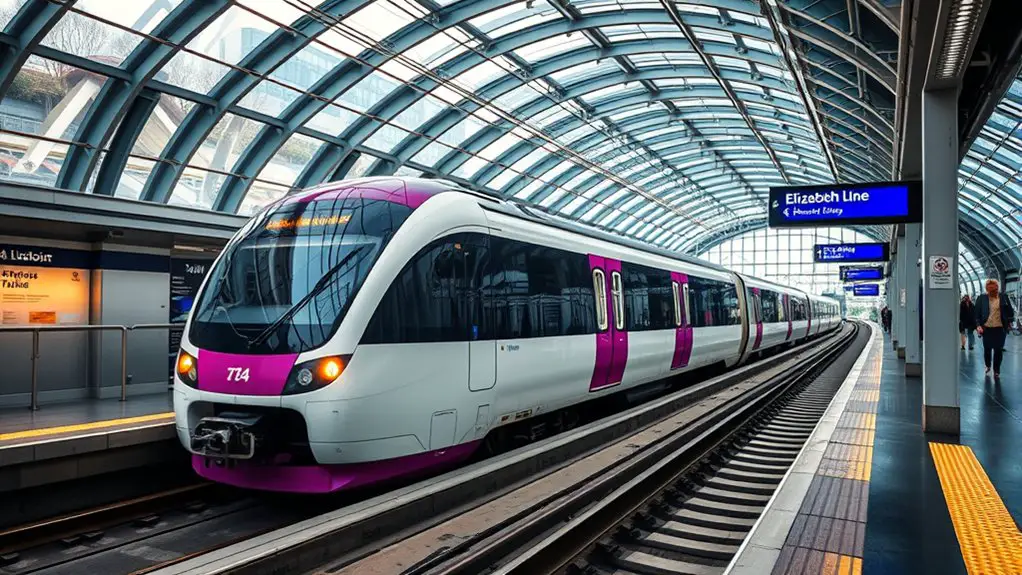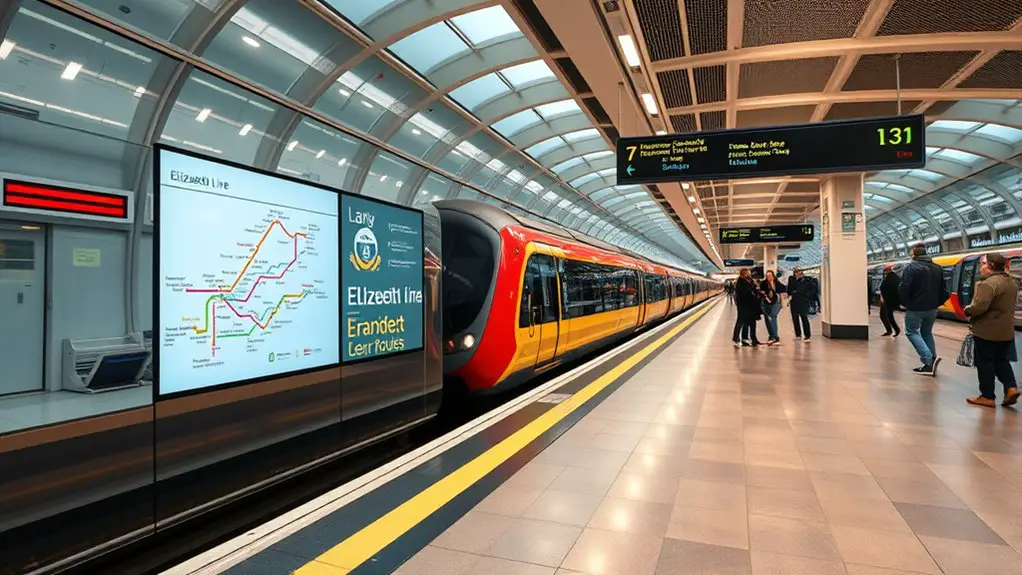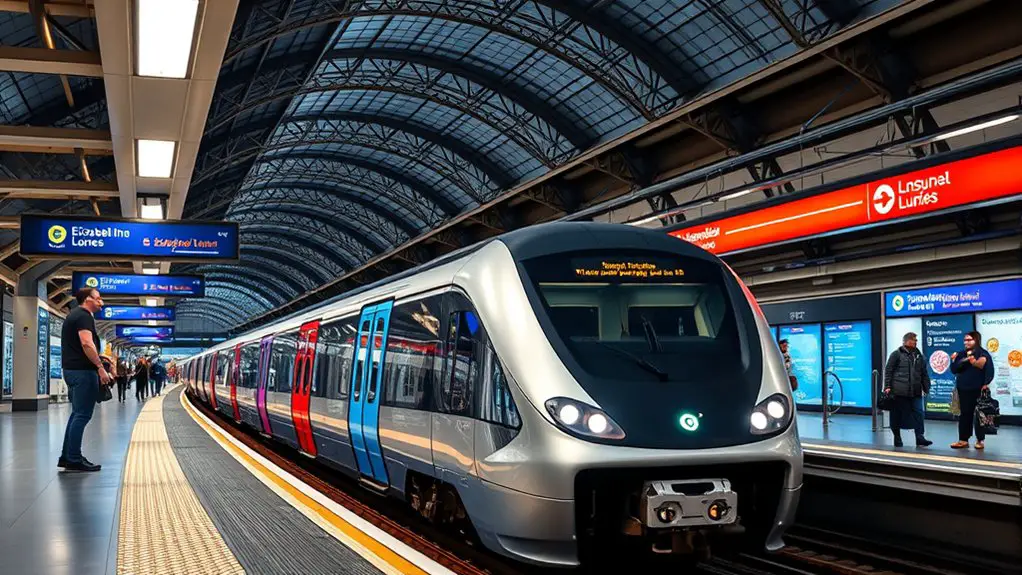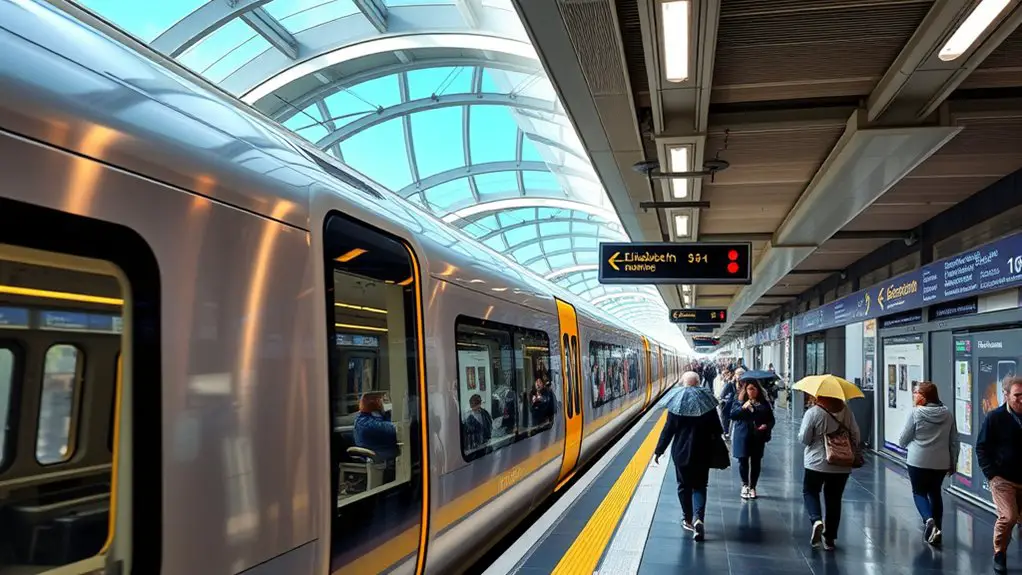The Elizabeth Line is an essential addition to London’s transport network, offering improved access across key districts. Understanding its routes, stops, and travel tips can greatly enhance your journey, whether commuting or exploring the city. With frequent services and connections to other transit options, mastering this line can save you time and hassle. To get the most from your travels, it’s crucial to know how to navigate its complexities—details that could change how you move around London.
Key Takeaways
- Overview of key routes connecting central London to suburbs, including main stops like Paddington, Liverpool Street, and Tottenham Court Road.
- Tips for navigating stations efficiently, such as planning ahead, checking real-time updates, and understanding station layouts.
- Service frequency details, with trains arriving every 5 to 10 minutes during peak hours for reliable travel.
- Advice on connecting to other London transit services using Oyster cards or contactless payments for seamless journeys.
- Recommendations for avoiding congestion by traveling during off-peak hours and monitoring service alerts.
Overview of the Elizabeth Line

The Elizabeth Line, also known as Crossrail, is a major railway project that greatly enhances transportation across London and its surrounding areas.
Its history overview reveals a long-standing plan to improve transit capacity and reduce congestion in the capital. Construction began in 2009, overcoming delays and technical challenges, and was completed in 2022.
The line introduces significant service improvements, including increased train frequency, modern stations, and seamless connections across existing networks. These upgrades enable faster, more reliable journeys, and better accessibility for passengers.
The Elizabeth Line offers faster journeys, modern stations, and seamless network connections for improved passenger accessibility.
The Elizabeth Line connects key hubs in central London to suburban areas, effectively easing bottlenecks on older lines. Its development reflects a strategic effort to accommodate London’s growing population and economic activity.
Key Routes and Main Stops

Key routes of the Elizabeth Line connect major hubs across London and beyond, forming an extensive network designed for efficient travel.
These key destinations include central locations like Paddington, Liverpool Street, and Tottenham Court Road, providing quick access to business districts, shopping areas, and cultural sites.
The line’s main stops are strategically positioned to serve both residential neighborhoods and commercial centers, enhancing mobility for daily commuters and tourists alike.
Service frequency is high, with trains typically arriving every 5 to 10 minutes during peak hours, ensuring minimal waiting times.
This consistency allows you to plan journeys confidently, whether you’re heading to the West End, Canary Wharf, or further afield into Essex and Berkshire.
Navigating the Elizabeth Line Effectively

Wondering how to maneuver the Elizabeth Line efficiently? To optimize your journey, focus on three key aspects.
Master the Elizabeth Line by planning ahead, checking station accessibility, and staying updated on real-time service changes.
- Plan Ahead for Peak Hours: The Elizabeth Line gets crowded during peak hours, especially at central stations. Travel outside these times if possible to avoid congestion and guarantee smoother access.
- Check Station Accessibility: Many stations offer step-free access and facilities for travelers with mobility needs. Verify station accessibility beforehand to streamline your movement, especially if you use assistive devices or luggage.
- Use Real-Time Updates: Stay informed on delays or service changes via the Transport for London app or station displays. This helps you adjust your route promptly, particularly during busy periods or when maneuvering stations with complex layouts.
Tips for a Smooth Journey
To guarantee a smooth journey on the Elizabeth Line, plan your trips during off-peak hours when trains are less crowded and stations are more manageable.
Effective journey preparation involves checking real-time schedules and station updates to avoid delays. Pack your travel essentials, such as a valid ticket or Oyster card, comfortable footwear, and a portable charger for your devices.
Familiarize yourself with station layouts in advance to streamline your movement and reduce stress. Consider downloading the Elizabeth Line app for live updates and route information.
Keep an eye on service alerts, especially during peak times or planned maintenance, to adapt your travel plans accordingly. Staying organized with your travel essentials guarantees quick boarding and minimizes disruptions.
Connecting to Other London Transit Services
Connecting seamlessly to other London transit services enhances your overall journey, ensuring smooth transfers and reducing travel time. To maximize efficiency, pay attention to key transfer points and fare zones.
- Identify nearby transfer points like Liverpool Street, Paddington, or King’s Cross St Pancras, which connect the Elizabeth Line to Tube lines, buses, and national rail services.
- Check fare zones—most Elizabeth Line stops fall within fare zones 1-6. Understanding zone boundaries helps you avoid unnecessary fare increases during transfers.
- Use an Oyster card or contactless payment to streamline transfers across services, as they often allow for free or discounted journeys within a specified time window.
Frequently Asked Questions
Are There Any Discounts Available for Frequent Travelers on the Elizabeth Line?
Yes, you can benefit from frequent traveler discounts on the Elizabeth Line through fare capping with Oyster or contactless cards.
This means after a certain amount spent in a day or week, your fares are capped, saving you money on multiple journeys.
Keep in mind that these options are most beneficial if you travel regularly, as fare capping automatically applies, providing a cost-effective way to commute without needing specific discounts.
What Are the Operating Hours for the Elizabeth Line on Weekends?
On weekends, the Elizabeth Line typically operates from around 6:30 am to 11:30 pm, but schedules can vary due to maintenance or special events.
During peak hours, trains run more frequently to accommodate higher passenger volume, especially in the mornings and evenings.
Check the Transport for London website or app for real-time updates on weekend schedules and peak hour timings, ensuring you plan your journey effectively.
How Accessible Are the Elizabeth Line Stations for Passengers With Disabilities?
You’ll find that Elizabeth Line stations are highly accessible for passengers with disabilities, thanks to extensive station facilities.
They include step-free access, tactile paving, and wide gates.
Assistance services are readily available; you can request help in advance or at the station.
These features guarantee smooth navigation, making your journey comfortable and safe.
Always check station-specific details beforehand to maximize your convenience and support during travel.
Is Wi-Fi Available on the Elizabeth Line Trains?
Yes, Wi-Fi connectivity is available on Elizabeth Line trains, enhancing your onboard experience.
This feature allows you to stay connected during your journey, whether for work or leisure. The Wi-Fi service is designed to be reliable and provides sufficient bandwidth for browsing, streaming, and communication.
What Safety Measures Are in Place on the Elizabeth Line?
On the Elizabeth Line, safety protocols include clear signage, CCTV surveillance, and regular security patrols.
Emergency procedures are well-defined, with accessible emergency exits and staff trained to handle incidents swiftly.
You’re encouraged to stay alert, follow posted instructions, and report any suspicious activity.
These measures guarantee a secure environment, allowing you to travel confidently while knowing that safety is prioritized through extensive protocols and prepared emergency responses.
Conclusion
The Elizabeth Line offers a fast, efficient way to navigate London’s transport network, connecting major districts and simplifying your travel experience. By understanding key routes, planning trips during off-peak hours, and using contactless payments, you can maximize convenience and reduce delays. Staying informed with real-time updates and familiarizing yourself with station layouts will guarantee smooth journeys. Ultimately, the Elizabeth Line enhances your mobility across London, making your trips more efficient and less stressful.
